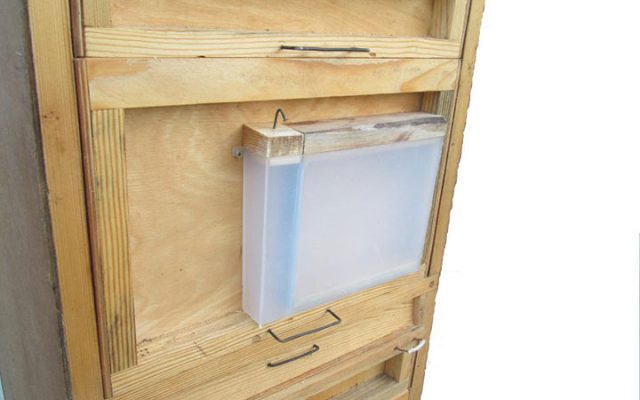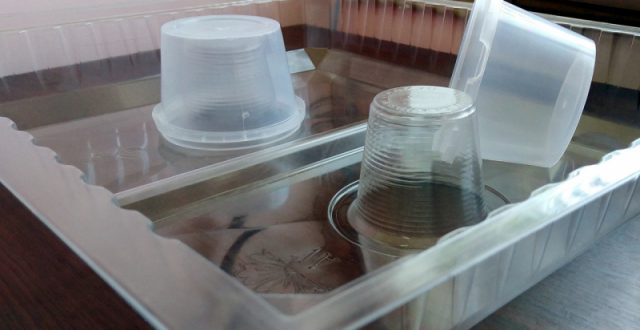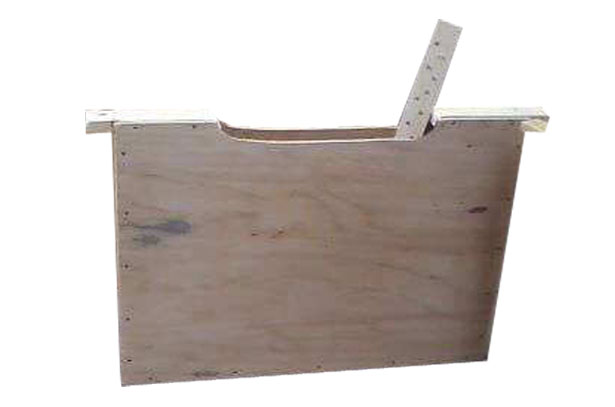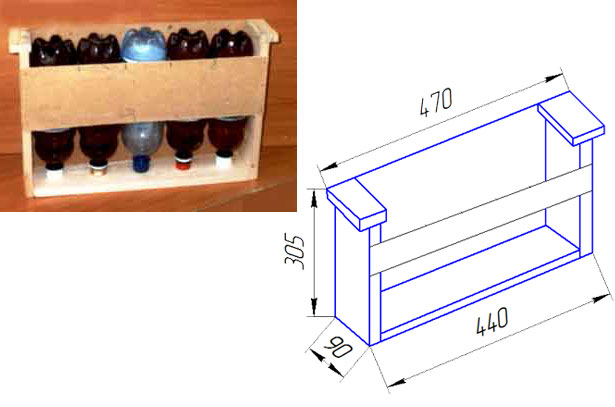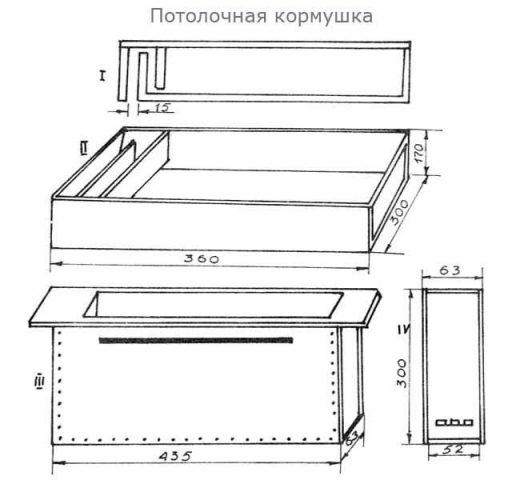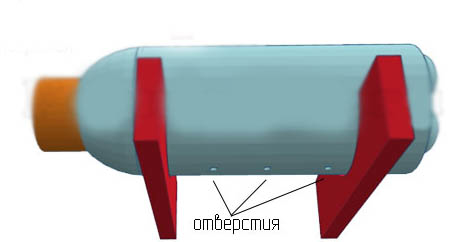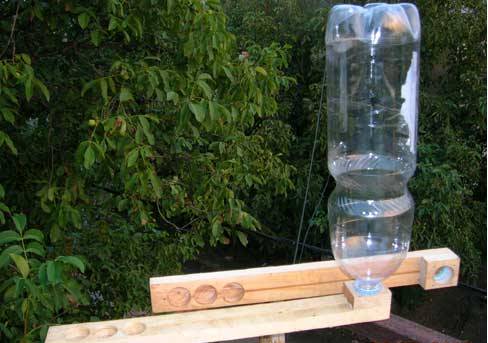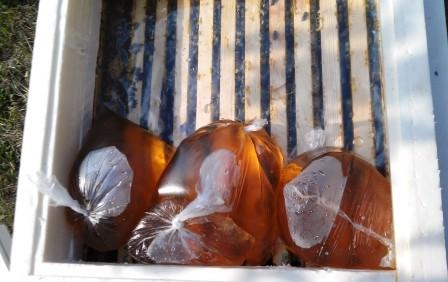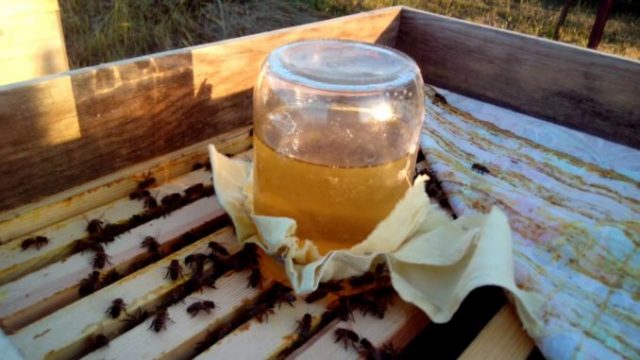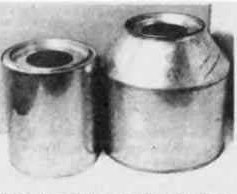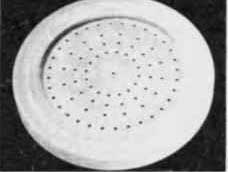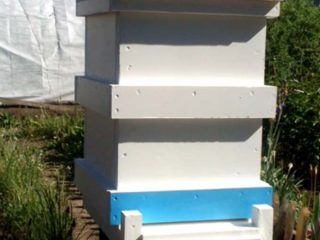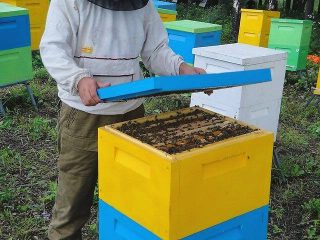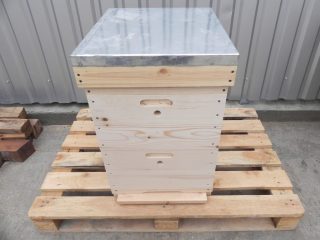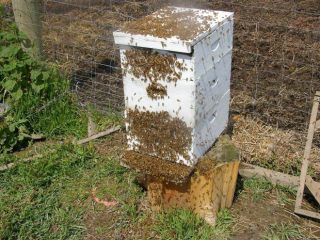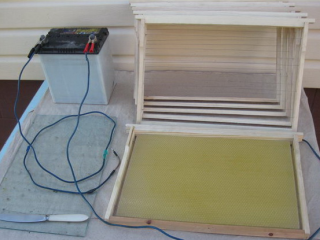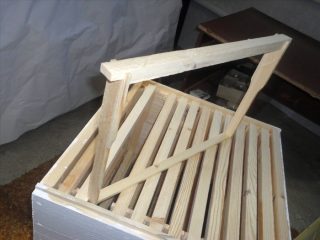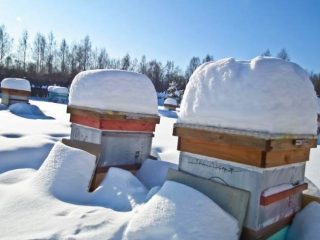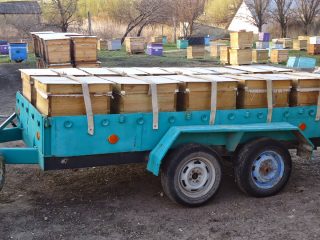Content
- 1 Do bees need feeders
- 2 Varieties of feeders for feeding bees
- 3 What material can be used to make feeders
- 4 Intra-hive feeder for bees
- 5 Frame feeder for bees
- 6 Vertical bee feeder
- 7 Ceiling bee feeder
- 8 Plastic bottle feeder for bees
- 9 What else can you make bee feeders
- 10 Which bee feeders are better
- 11 Conclusion
Bee feeders are easier to buy at the store. They are inexpensive. However, many beekeepers are accustomed to making primitive containers in the old fashioned way. In addition, this experience will not hurt if the apiary is located far in the field. When there is no store nearby, and the feeders are urgently needed, ingenuity comes to the rescue.
Do bees need feeders
Mandatory feeding of bees is carried out at least 2 times a year. The first time is in early spring before the flowers bloom. The second feeding is carried out in the fall. The procedure is aimed at replenishing feed stocks for the winter. There are additional feeding with sugar syrup when it is necessary to replace low-quality honey or reduce the cost of winter food. Feeding troughs have been invented to organize the feeding of bee colonies.
Varieties of feeders for feeding bees
There are many varieties of factory and homemade bee feeders, but they are all divided into 2 types, depending on the installation location:
- external;
- internal.
In turn, external devices are:
- Hinged. The attachments are made in the form of a box and are usually fixed on hives or in the vicinity. Plus - ease of service. Minus - wasps and other people's bee colonies steal food.
- Are common. A large container with sugar syrup acts as a feeder. It is installed near the apiary. Twigs or a wooden bridge float on top of the syrup in a container so that insects do not drown. Plus - simplicity of design and maintenance. Minus - bees from different families receive food unevenly.
There are much more varieties of internal feeders:
- Framework. The fixtures are made in the form of containers to fit the frame. Attach the box near the nest. Plus - it is convenient to feed the bee colonies in rainy weather. Minus - to add food, insects must be disturbed.
- Disposable polyethylene. The feeder is an ordinary bag filled with syrup and tied with a knot on top. Place them at the bottom of the hive or on top of the frames. Instead of syrup, medicinal solutions for the treatment of bees can be poured into the bag. Plus - simplicity, low cost, availability in the field. Minus - rapid cooling of the poured solution.
- Ceiling. At least two versions of such feeders are common among beekeepers. It is good to wash plastic models, it is convenient to place in the hive, but insects sometimes penetrate into the glass and die. Box-type feeders are beneficial in large apiaries. The constructions allow feeding bee colonies for a long time without opening the hives to add feed.
- Bottled. Feeders are made from PET bottles. By location, they are vertical, standing at the bottom of the hive, or horizontal, suspended by means of fastening bars.
Any container can be used as an internal feeder. They use glass and tin cans, make foam models and other devices.
What material can be used to make feeders
If you look at the photo of the bee feeders, you can be convinced of the inexhaustible imagination of the beekeepers.Containers are made most often from wood, glass, foam. Popular materials are polyethylene and other types of plastics, but the polymer is only used for food. If the product emits toxic odors, the quality of honey will deteriorate or the bee colonies will die.
Intra-hive feeder for bees
From the name it is clear that any feeder installed inside the hive is called intrahive. At the location, the structure can be ceiling, floor or side. The first two types include products from bottles, bags, boxes. Depending on the model, they are placed on the bottom of the hive or suspended from the ceiling. The side feeder is placed next to the honeycomb.
How to make a do-it-yourself bee feeder
The side model is considered the most effective intrahive feeder. It is made in the form of a plywood flat box. The syrup is poured through the top funnel. Be sure to equip a floating bridge that prevents the bees from drowning. The top of the box is equipped with two fastening lugs for fixing the socket on the side.
You can take a closer look at the assembly of the hive feeder in the video:
Frame feeder for bees
The most common side feeder in the manufacture is the frame model. The dimensions of the container are identical to the frame with honeycombs. The product is similarly made in the form of a box with an open top for pouring syrup. Inside, a floating bridge is being built to prevent the bees from drowning. A self-assembled frame feeder for bees is installed instead of a frame on the side of the nest, suspended from the wall with hooks.
How to make a bee feeder
It is easy to build a frame device for feeding bees. An ordinary frame is freed from honeycombs and wire. The sides are sheathed with plywood. It is important to securely seal the joints to prevent syrup from leaking out. Wax can be used. The upper frame jumper is removed to form a container. A floating bridge is being set up here. A cover is cut out of a piece of plywood, a hole is drilled. The device will limit the mass contact of bees with food. In addition, the funnel is used to top up the syrup through the watering can.
Vertical bee feeder
A battery made of PET bottles can be used as a vertical feeder. The box-type design is a cassette made of plywood or thin boards, inside which containers with bee syrup are installed vertically with the neck down.
Manufacturing process
The photo shows do-it-yourself drawings of a bee feeder, but you need to calculate your own dimensions according to the dimensions of the hive. First, 4-5 identical bottles are selected, their diameter is measured. According to the measurements carried out, the thickness of the cassette is determined. The boxes are assembled from plywood or thin strips.
With an awl or a nail along the ring of the bottle, they pierce the holes, stepping back 1 cm from the bottom. They are needed to supply air to the container so that the liquid does not hang. There is a sealing insert inside the plug. It is removed. The bottles are filled with syrup, loosely sealed with corks without seals, turned upside down and placed inside the box. The cassette is placed inside the hive on the side of the bee nest.
Ceiling bee feeder
The box-type model is considered a universal ceiling feeder. They fix the structure in the folds or set it on a base, where a hole is pre-drilled so that the bees can get to the food. The box is made so long that it fits between the back and front walls of the hive. Divide the container for bees into 3 sections:
- filling chamber for syrup;
- aft compartment with a floating bridge for bees made of plywood or foam;
- small compartment for the passage of bees into the aft compartment.
A dividing partition is placed inside the aft compartment, which does not reach the bottom of about 3 mm. In the third compartment, the partition does not reach the top of 8 mm. There is no bottom at the bottom, due to which a gap is formed for the bees to access the feed compartment.
Manufacturing process
When assembling a ceiling feeder for bees with your own hands, first knock down the box. In the upper part of the sidewalls, grooves are cut. The pouring chamber for the syrup is covered with a fiberboard blank. The two received compartments are equipped with a common glass cover. It is convenient to observe the bees through the transparent surface. To avoid the leakage of syrup, the joints of the box are planted on PVA glue, tightened with self-tapping screws. Outside, the seams are additionally sealed with wax.
Plastic bottle feeder for bees
The advantage of the simplest device is the economic benefit. You can collect empty PET bottles for free. After feeding the bees, they are simply thrown away, which eliminates unnecessary cleaning and disinfection work. The disadvantage of the device is the rapid cooling of the syrup in the bottles. Feeders are used most often in hives with a low roof.
Traditionally, do-it-yourself bee feeders from a plastic bottle of two types: horizontal and vertical. For manufacturing, you will need containers of 1.5-2 liters, an awl, scotch tape, a jigsaw.
Manufacturing process
To make a horizontal model, a straight line is drawn with a marker on the side wall of the bottle from the neck to the bottom. According to the marking, up to 7 holes are pierced with an awl at an equal distance.
2 holders with recesses for a bottle are cut out of bars or pieces of chipboard. The elements are attached to the wall of the hive. The side holes on the bottle are sealed with tape. The container is filled with syrup, corked. The scotch tape is abruptly torn off, the bottle is placed on the holders with the holes down. The flow rate of the syrup will depend on its viscosity and the diameter of the holes.
For the vertical model, the bottle is prepared exactly as the cassette design was made. Holes are pierced near the bottom, sealed with tape. The container is filled with syrup. The seal is removed from the plug, the neck is not tightly sealed. The bottle is turned over, the tape is ripped off. A block with a cut-out hole along the diameter of the cork is used as a stand. You can cut a groove along which the syrup will flow. Additionally, a vertically installed bottle inside the hive is fastened with a clamp to the wall.
What else can you make bee feeders
Basically, you can feed the bees from any container and even use a PET packaging bag. Each device has its pros and cons, but helps out in the field.
From packages
The good thing about the disposable feeder is that it doesn't need to be disinfected, as there is no need to reuse it for the bees. The bags are cheap, but they differ in strength and size. They are selected by the type of feeding.
If the bees require stimulating feeding, a small amount of the sweet mixture (up to 1 liter) is poured into small thin-walled sachets. For winter replenishment of stocks, it is optimal for bees to use large thick-walled bags containing 3-4 liters of syrup.
During feeding, the bag is filled with a sweet mixture, excess air is released, tied in a knot a third higher from the feed. In the air-free space, the syrup will spread when the bag is spread over the frames. At the request of the beekeeper, the feeder can be placed behind the bar inside the hive.
For stimulating feeding, the sachets are placed on the frames intact. The bees gnaw them themselves. In a large bag for a complete replenishment of food, a couple of holes are punched on the side and one on top to lure the bees.When all the syrup is drunk, the old bags are thrown away, and a new portion of the food is put into the hive.
From cans
If there is an empty housing installed above the frames in the hive, the bee feeder is placed from a glass jar. You will need a thick gauze folded in eight layers. It is soaked in clean water, squeezed well. The jar is filled with syrup. The neck is covered with gauze, tied with a rope or elastic band. The jar is turned upside down, placed on top of the frames.
The simplest feeder for bees is shown in the video:
From tin cans
Glass containers can be successfully replaced by cans. The principle of making a feeder is the same. You will need the same gauze in 8 layers. Sometimes tin cans come with nylon lids. They can be used instead of gauze, piercing many small holes with an awl.
The jar of syrup is turned upside down, placed on a frame. For better access of the bees to the food, thin blocks are placed under the container.
Styrofoam
Foam feeders are factory-made. A similar ceiling model can be glued from sheet polystyrene. However, there is an easier option. For homemade products, you need a conical PVC container with a diameter of about 200 mm, a piece of chintz cloth, an elastic band, a foam plate 30 mm thick.
A circle is cut out of the foam plate with a sharp knife. In diameter, it should fit tightly into the neck of the cone-shaped container. A hole 7 mm thick is punctured in the center of the foam disk, and grooves are cut from it from the outside. On the sides of the disc, 4 more grooves with a depth of 5 mm are cut. Syrup is poured into the cone. The container is closed with a foam disc. A chintz fabric is pulled from above and the cone is turned over. If the syrup flows quickly through the fabric, add another 1-2 layers until an even distribution begins. The feeder is fixed inside the hive with grooves cut on the side of the foam disc.
Which bee feeders are better
It is impossible to pinpoint the best feeder. A certain type of model is selected, depending on the amount and time of feeding, the design of the hive, the frequency of the appearance of the beekeeper on his farm.
It is considered the best one that meets all the requirements:
- bees get access to food in any weather;
- the design is easy to clean, disinfect or disposable;
- bees should not get wet and die in a sweet liquid;
- the feeder should not attract wasps and other bees;
- the minimum contact of the service person with the bees is desirable during the loading of the feed;
- the beekeeper must see the amount of uneaten food.
Taking into account the listed requirements, the beekeeper himself determines the best suitable option.
Conclusion
A good beekeeper always has a feeder for bees at the ready: serviceable, clean, disinfected. They can be used immediately in case of urgent need.
